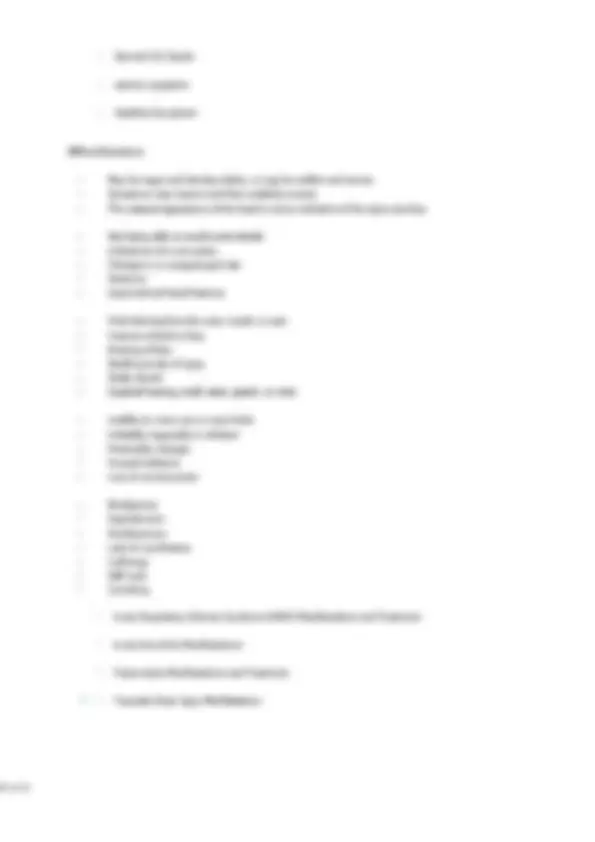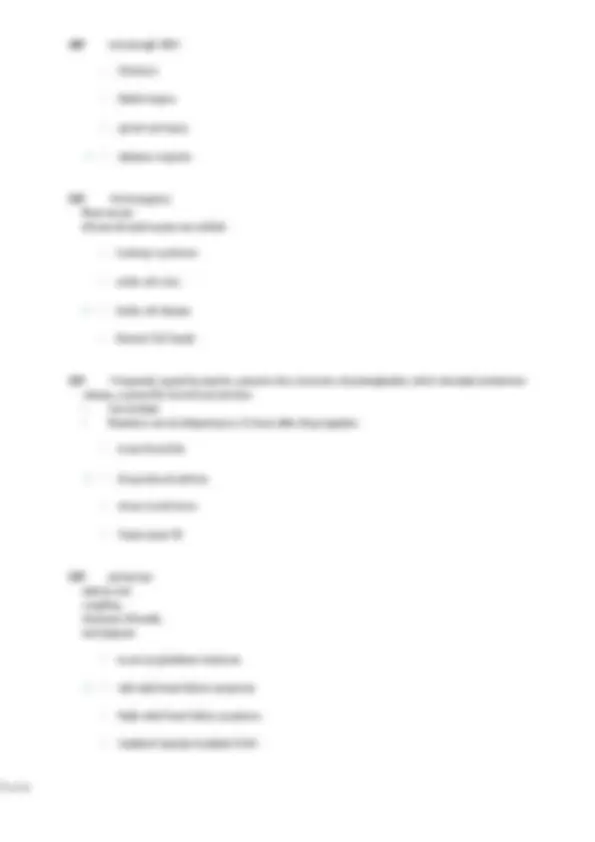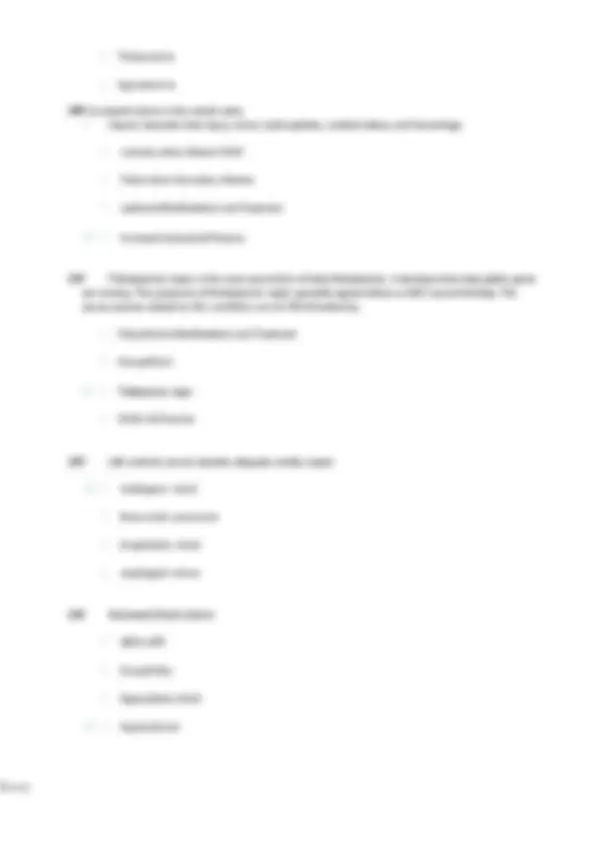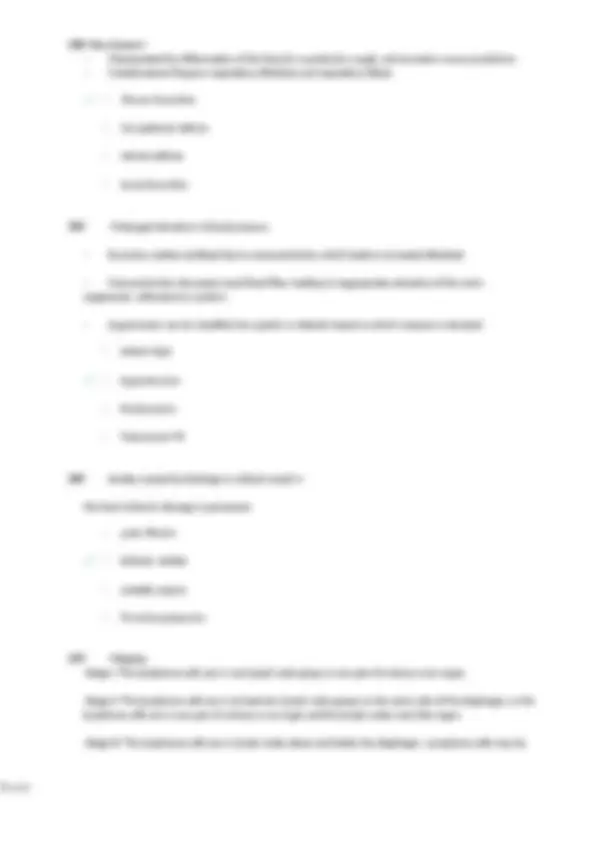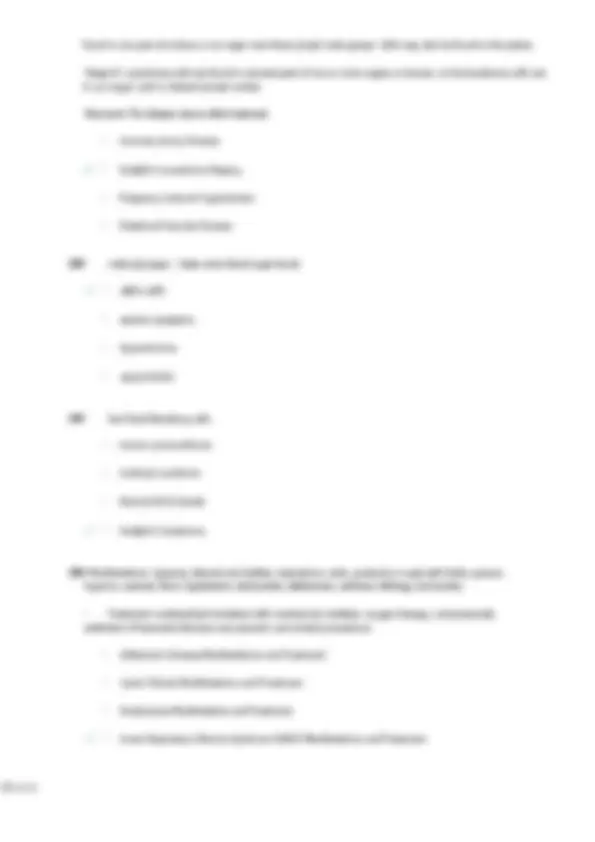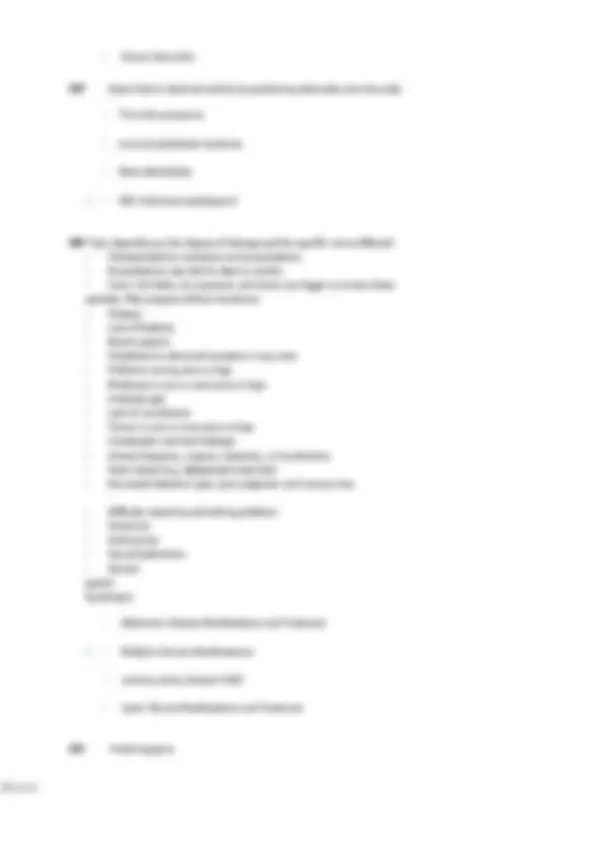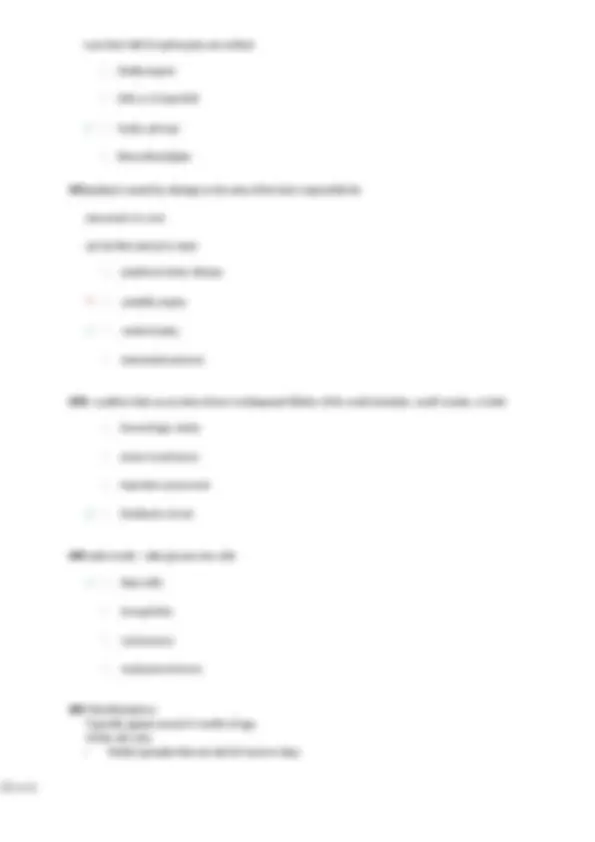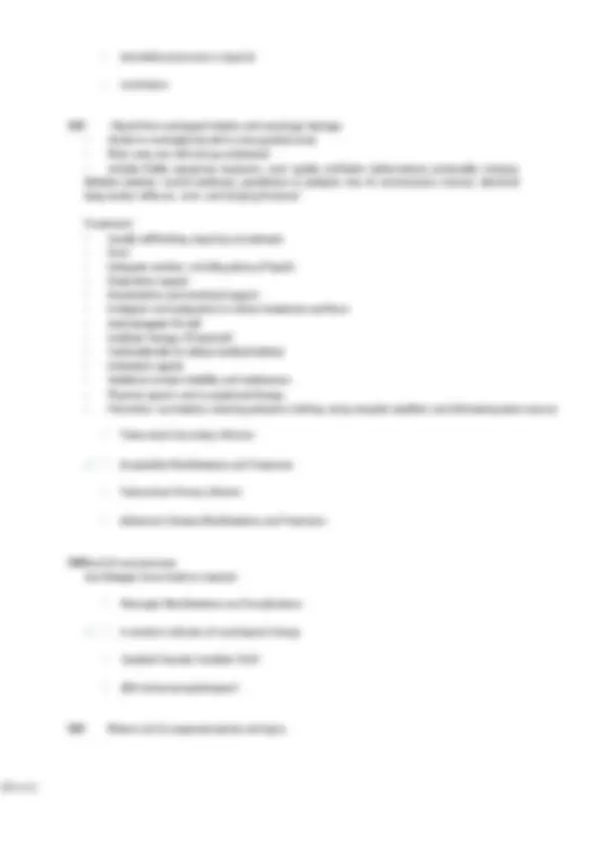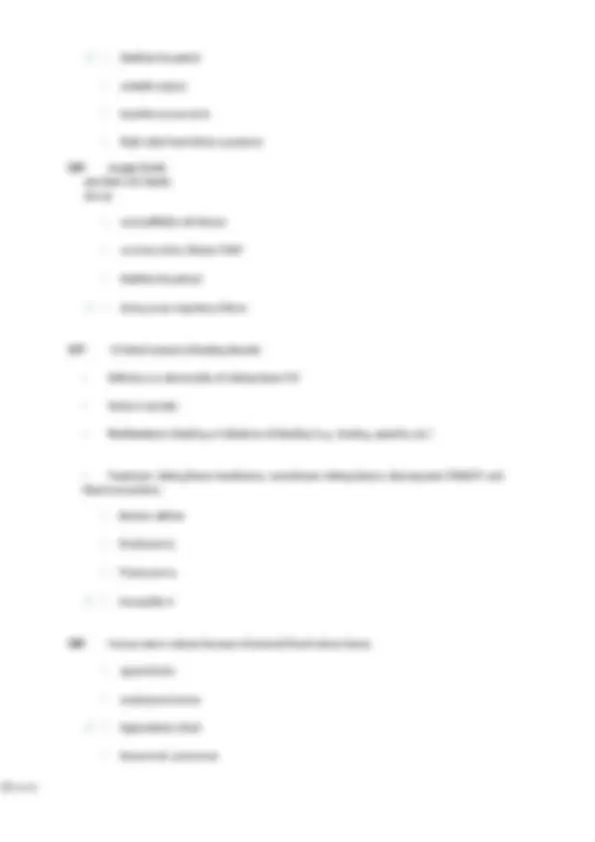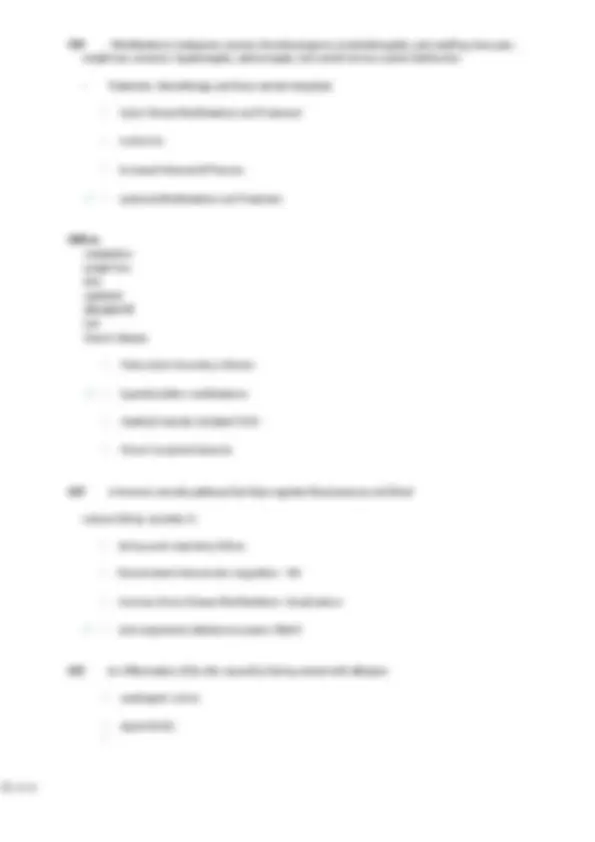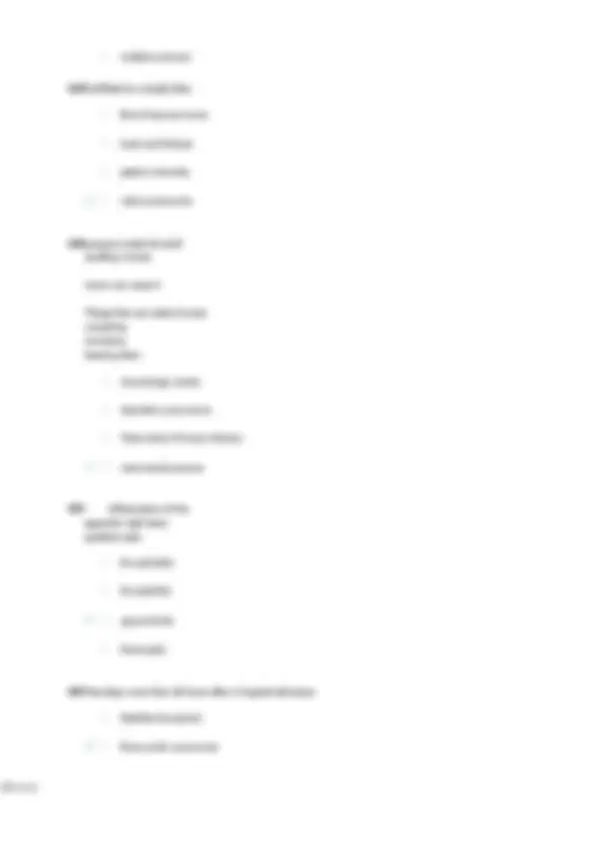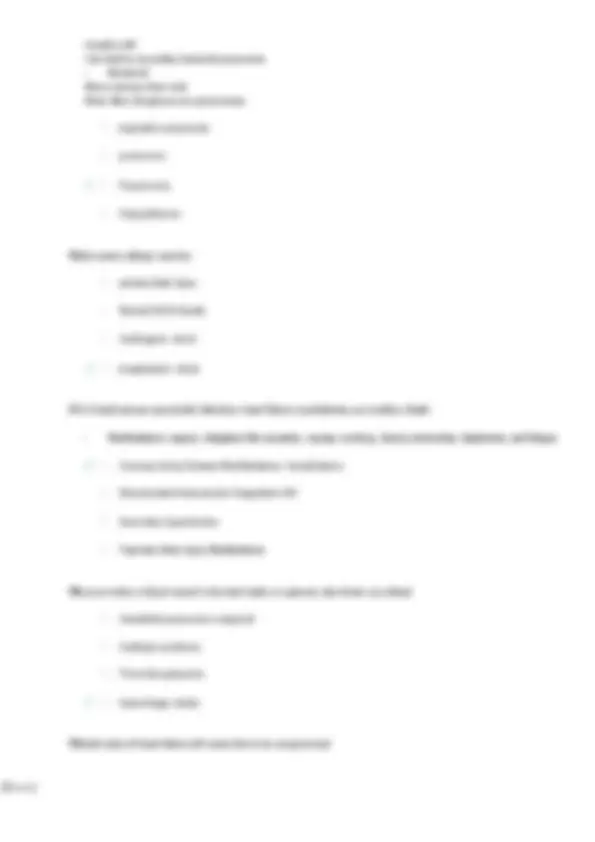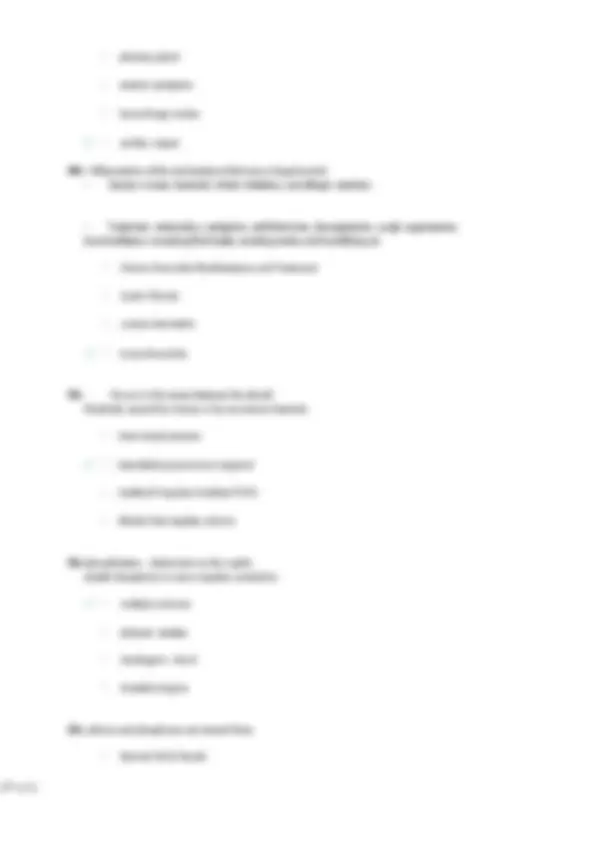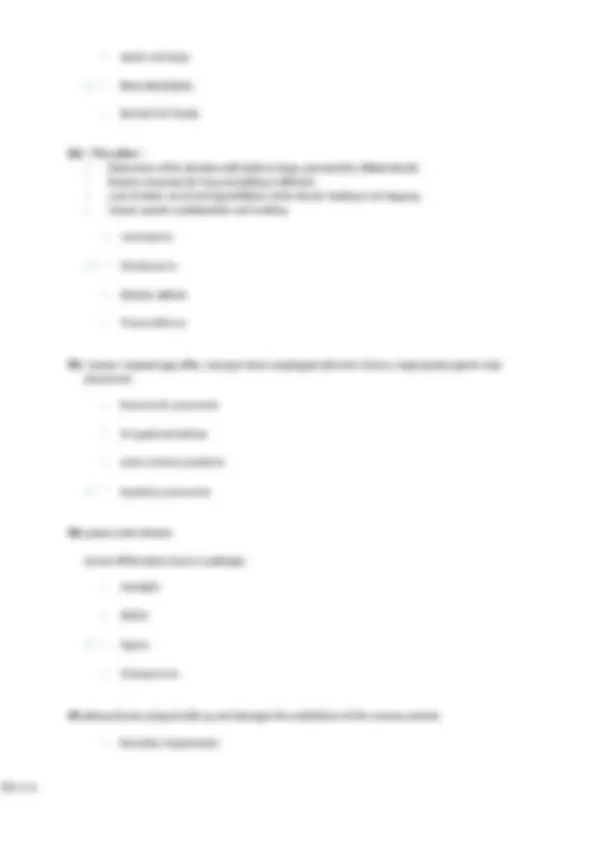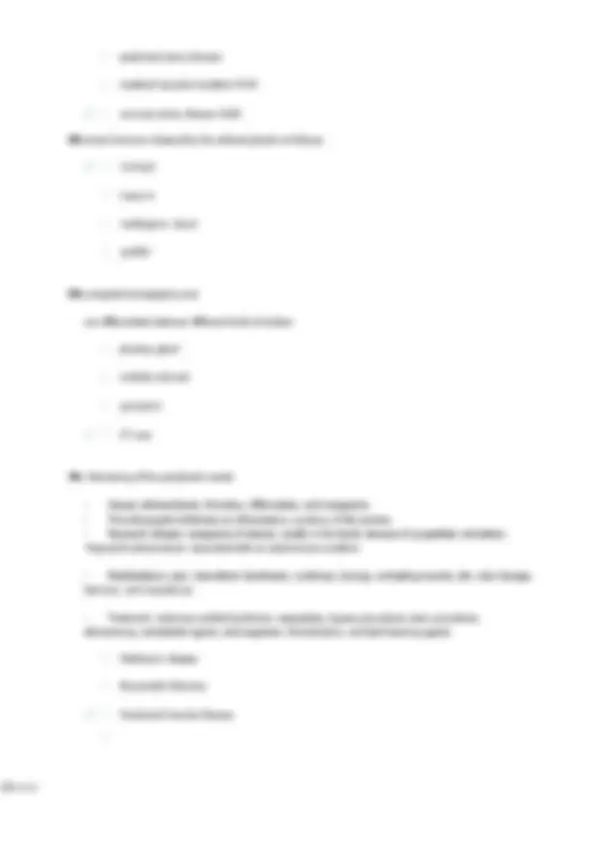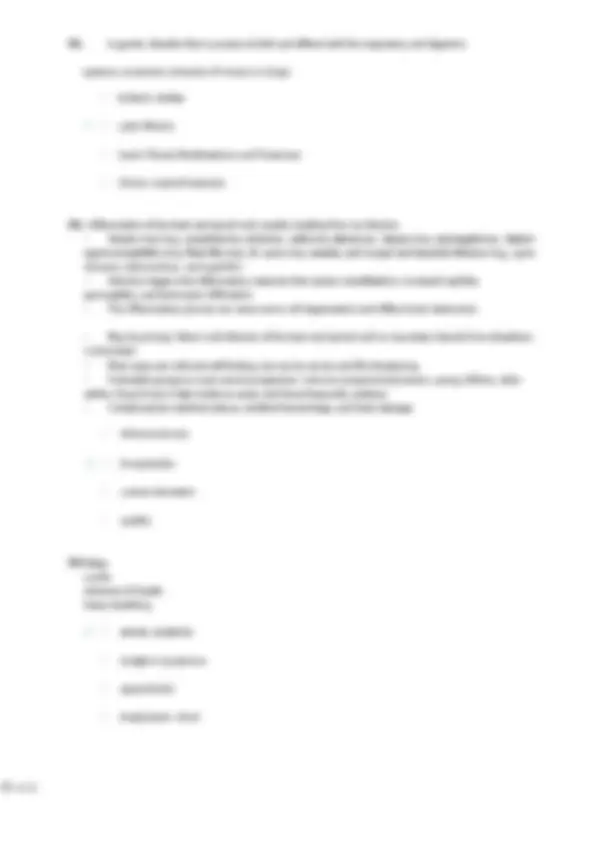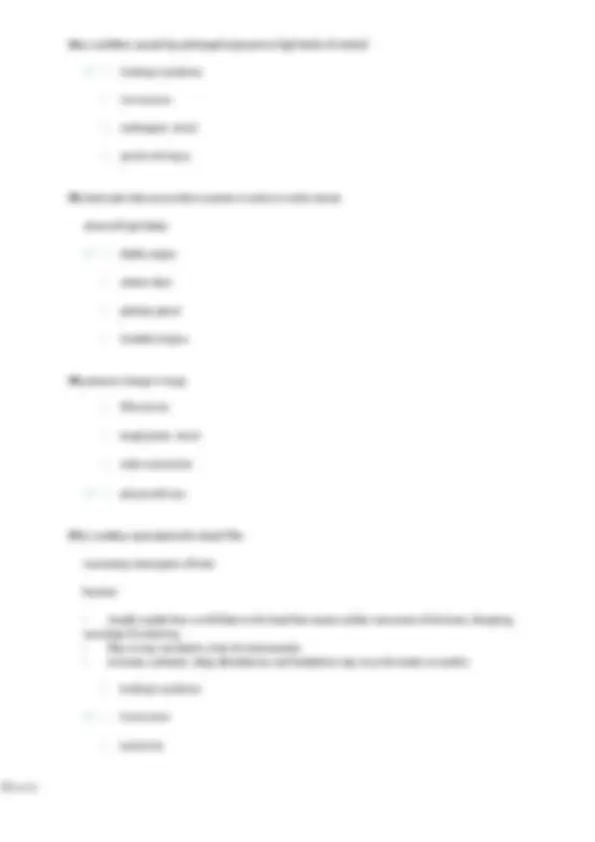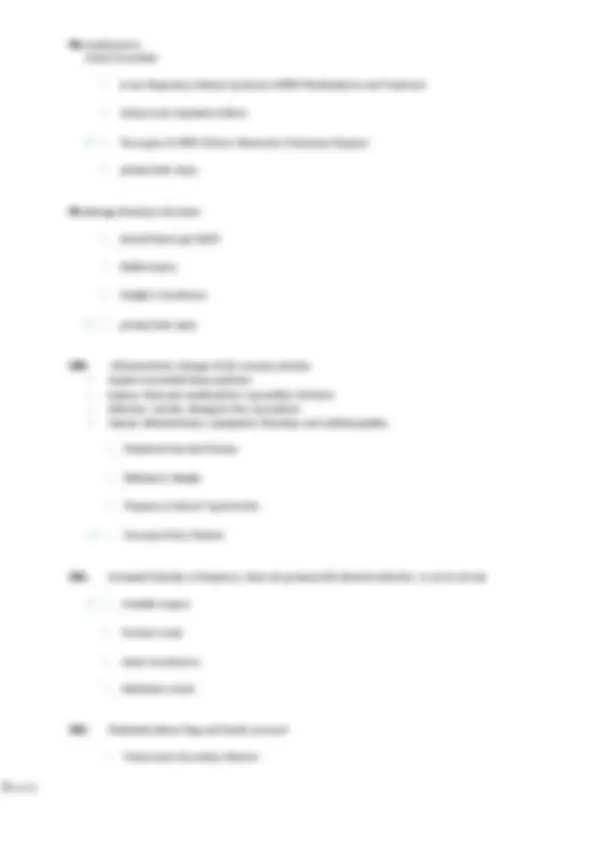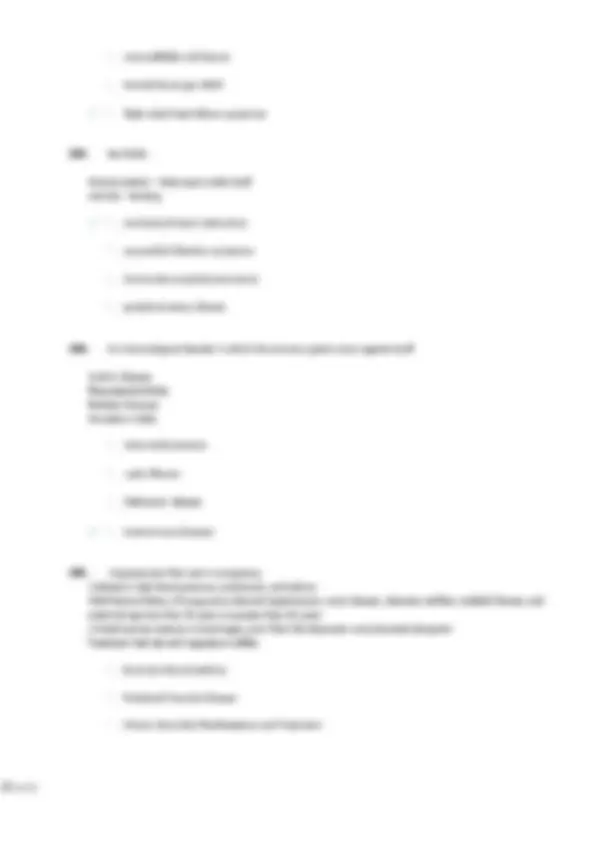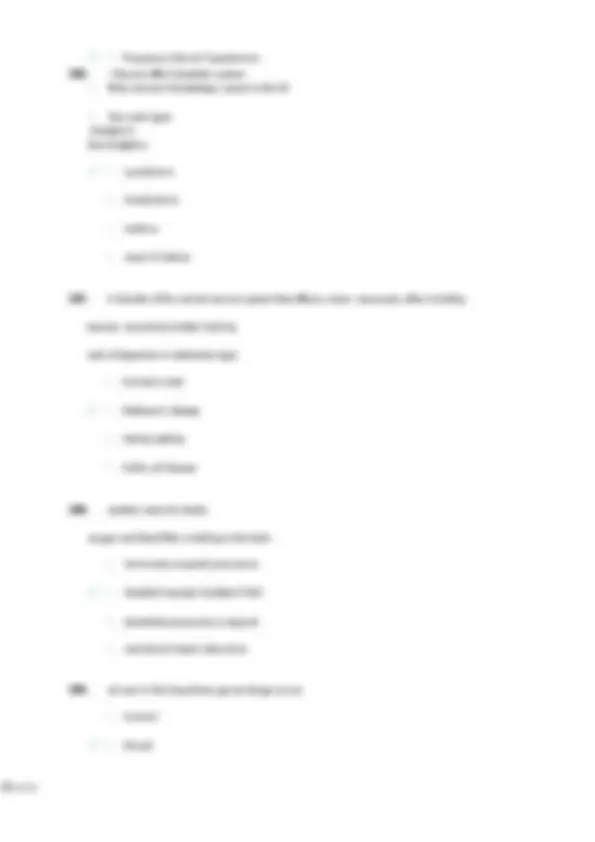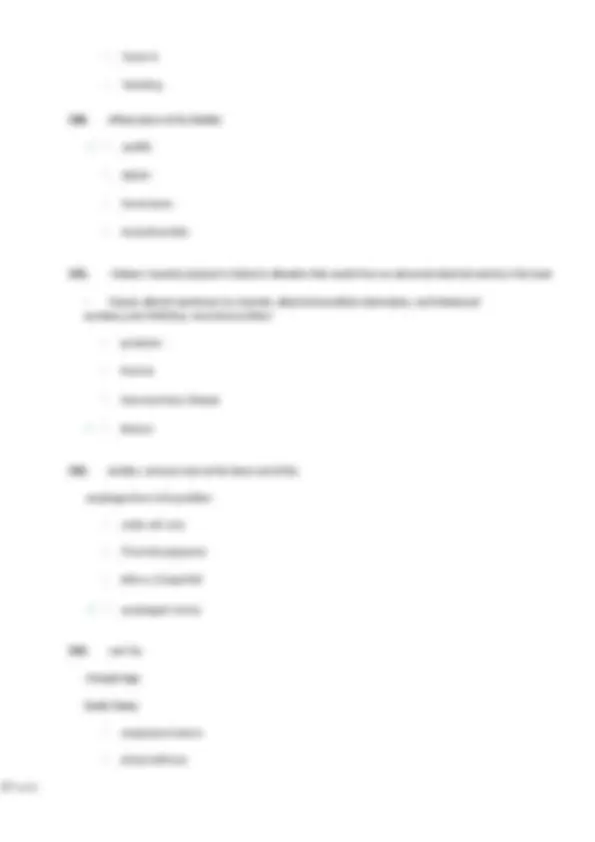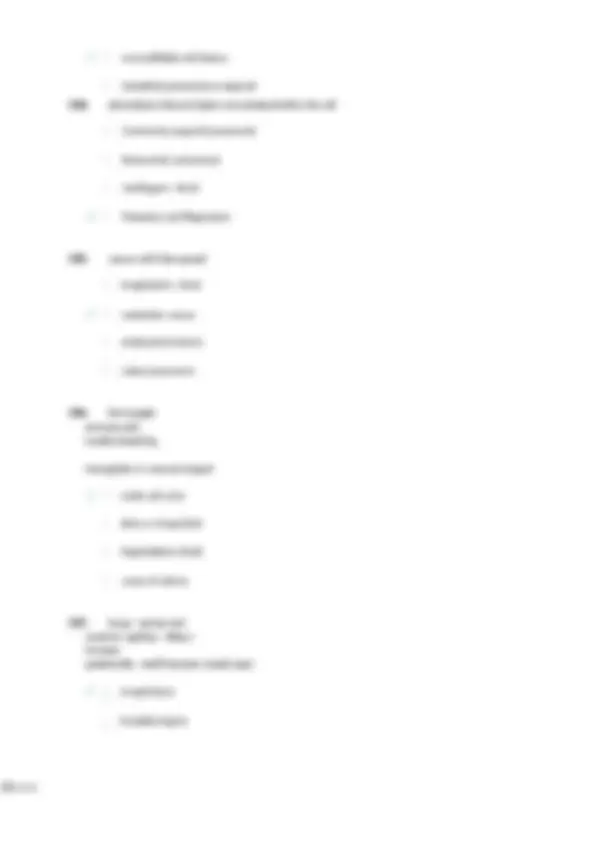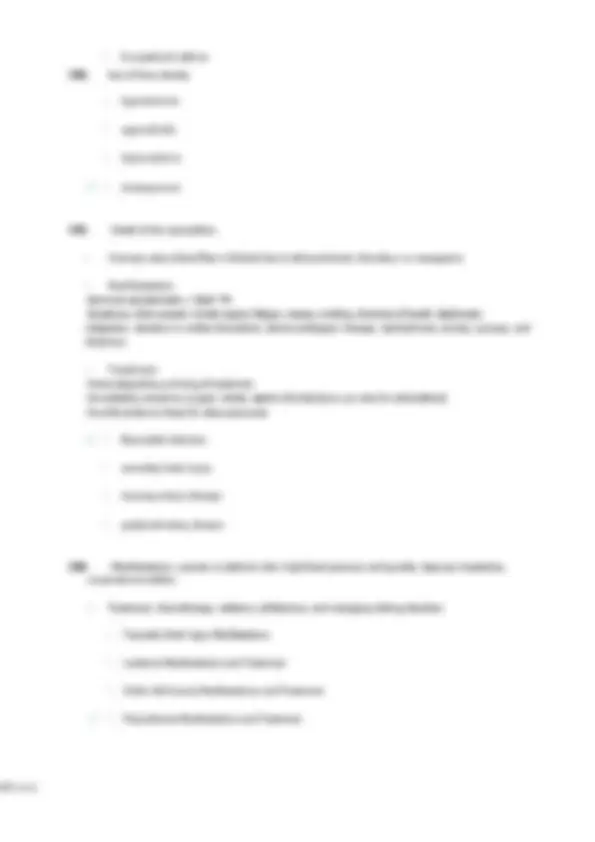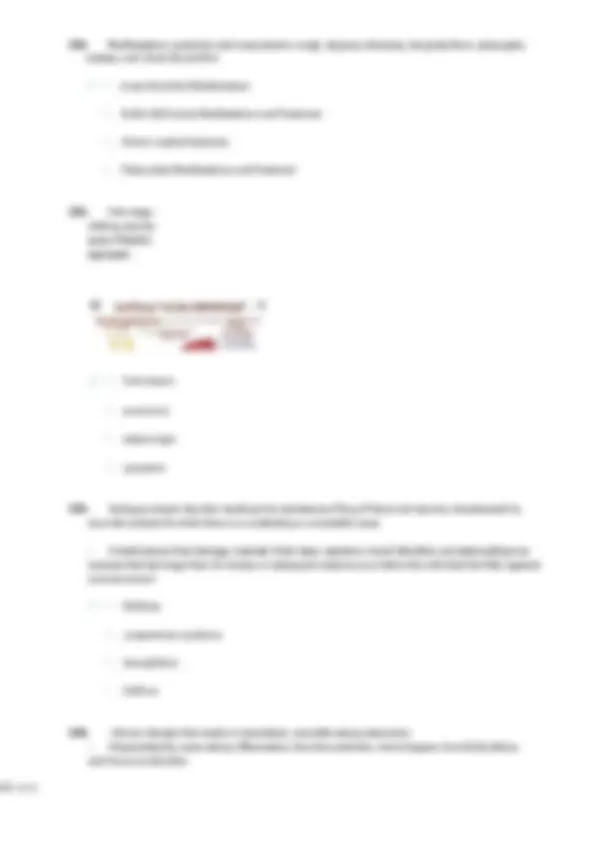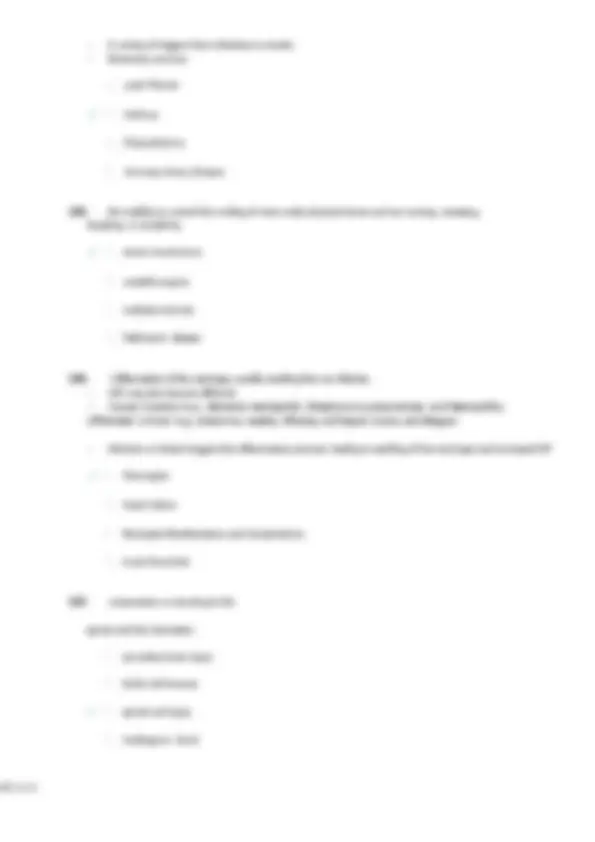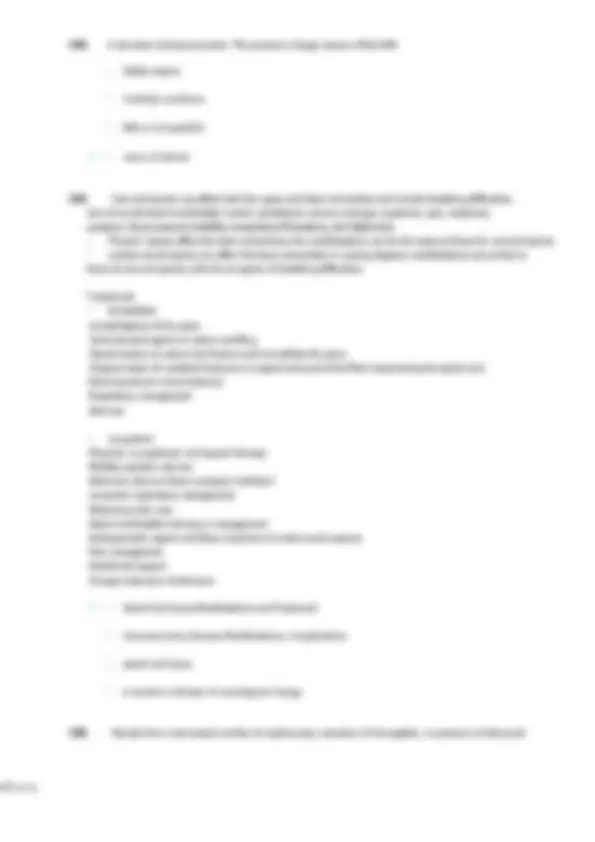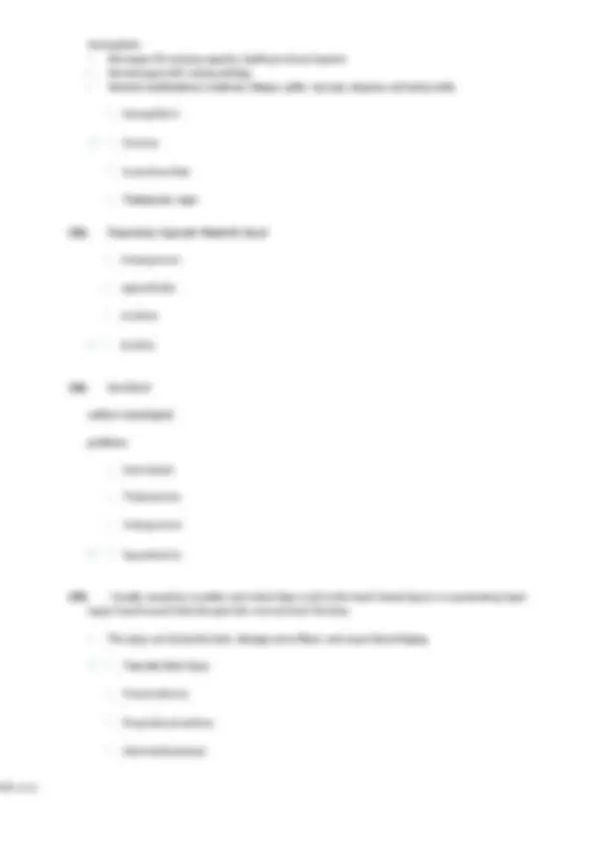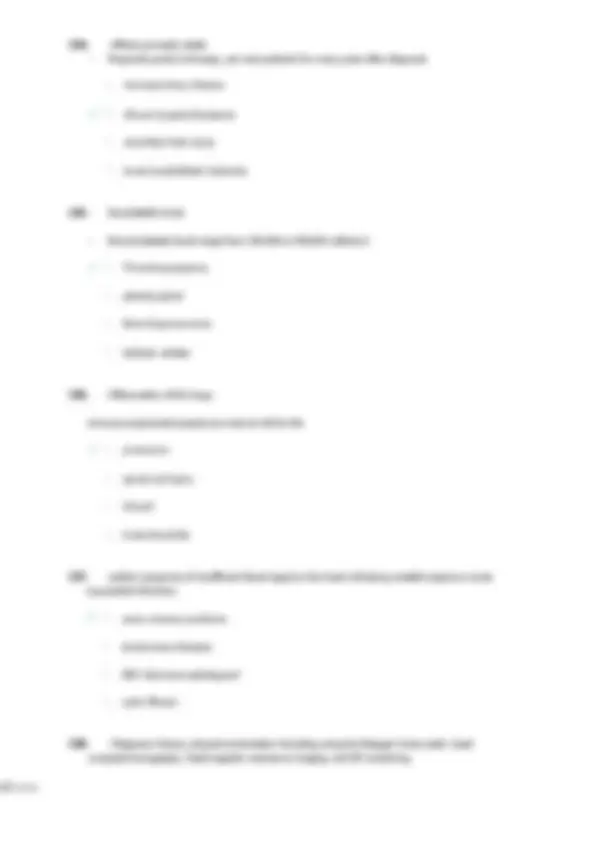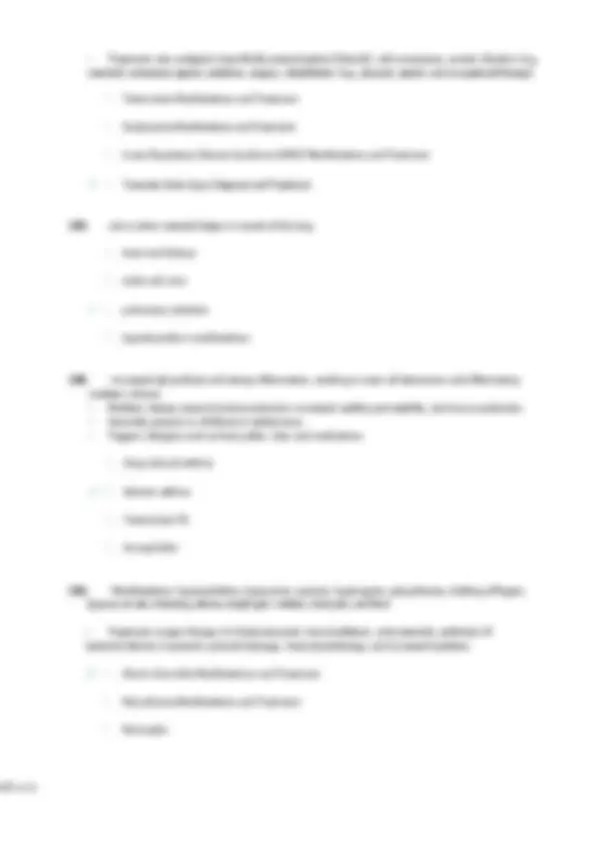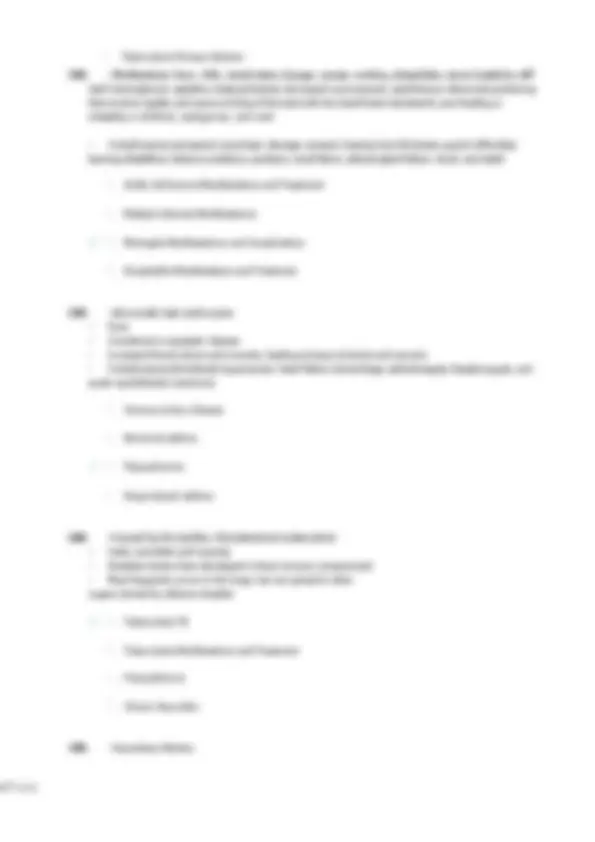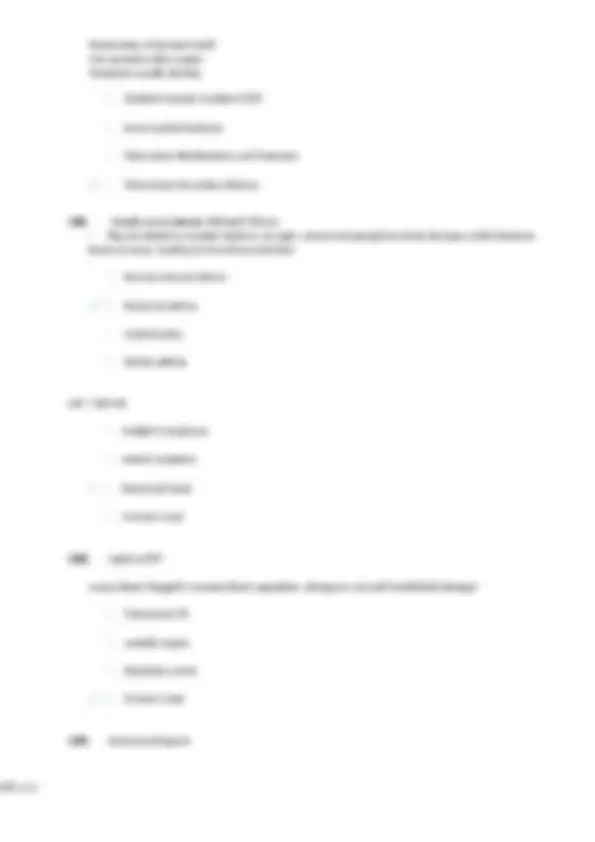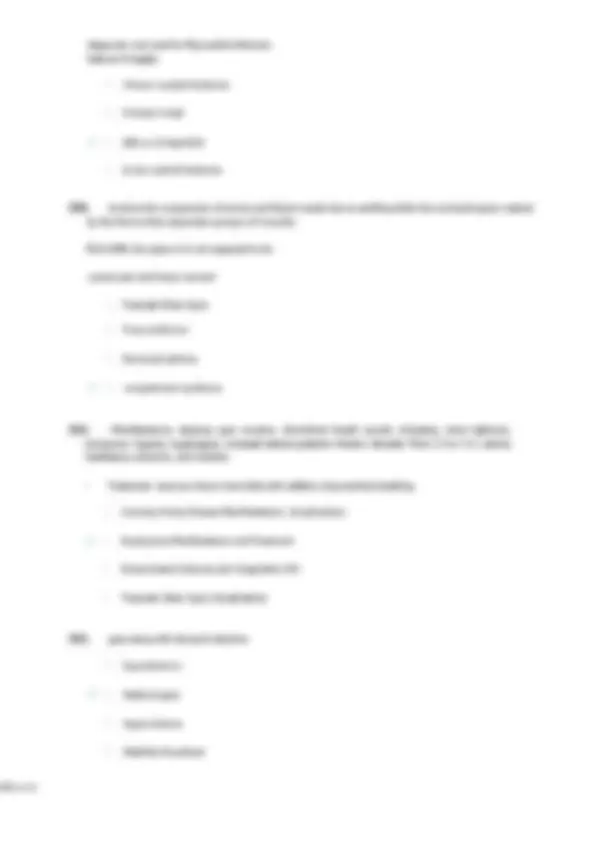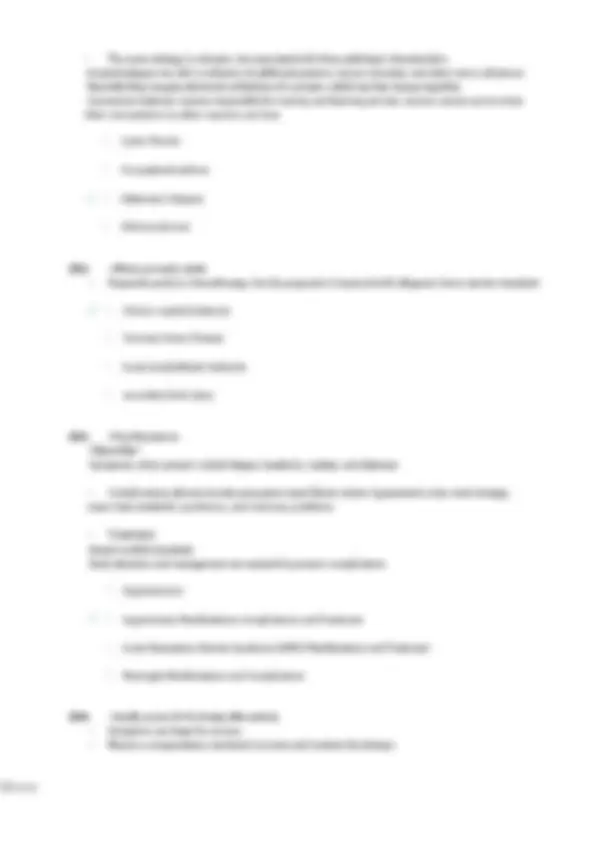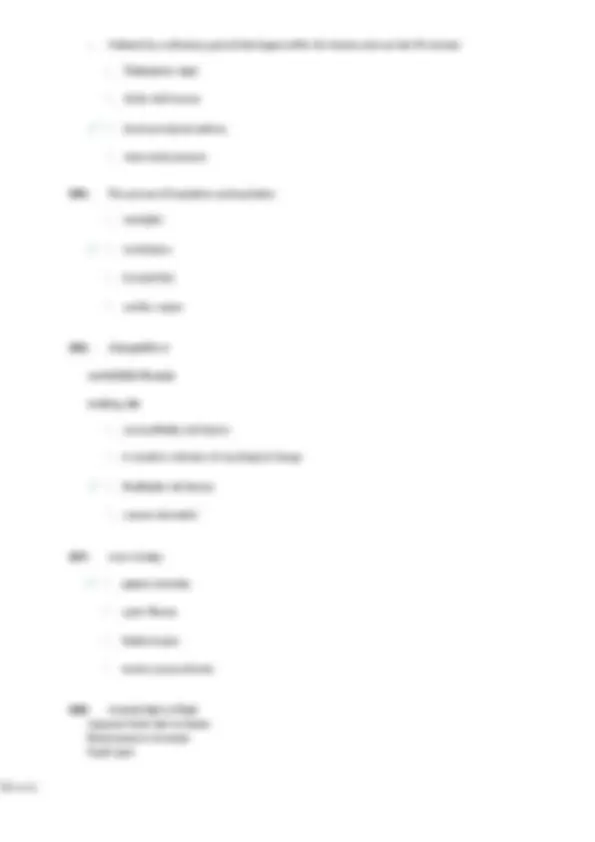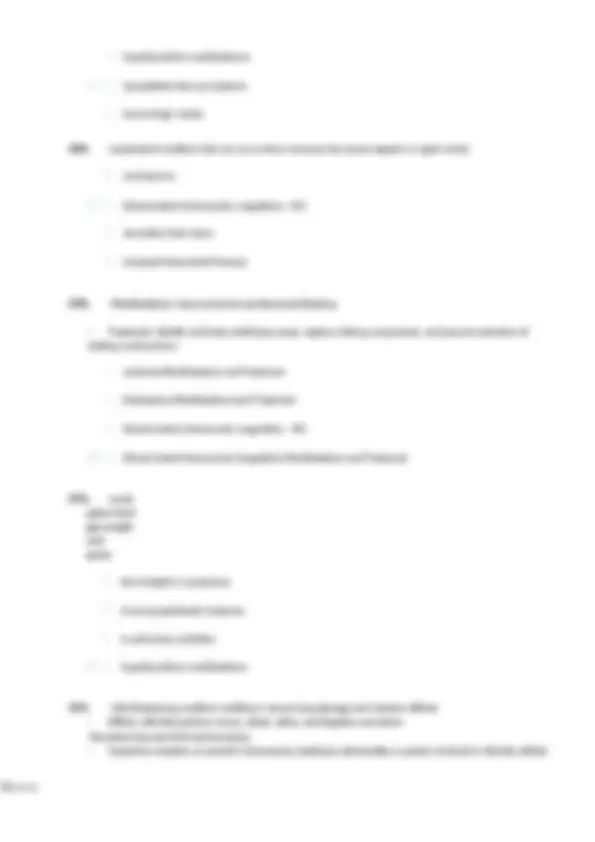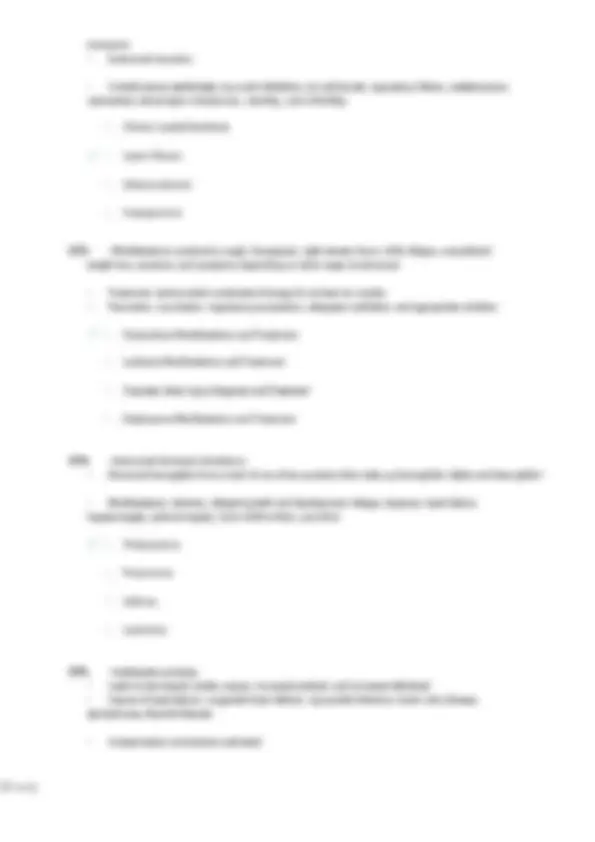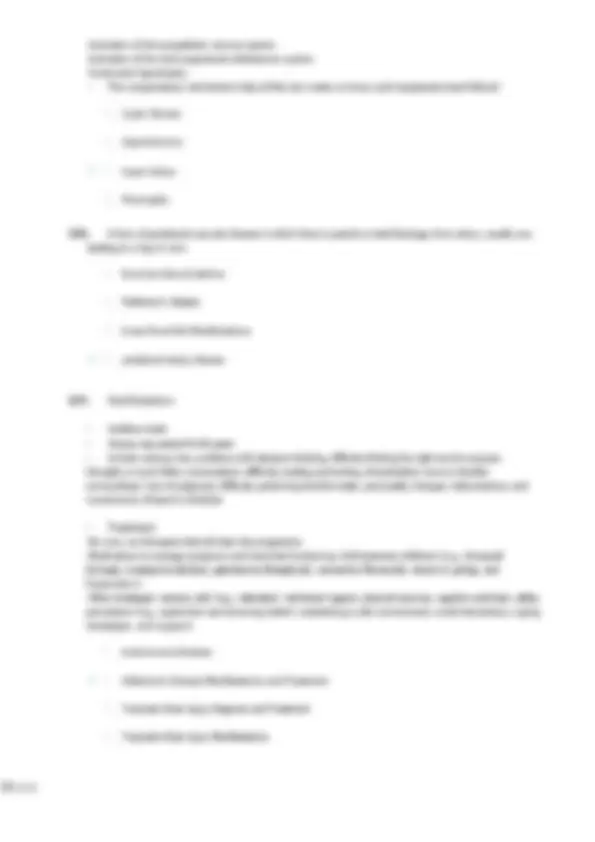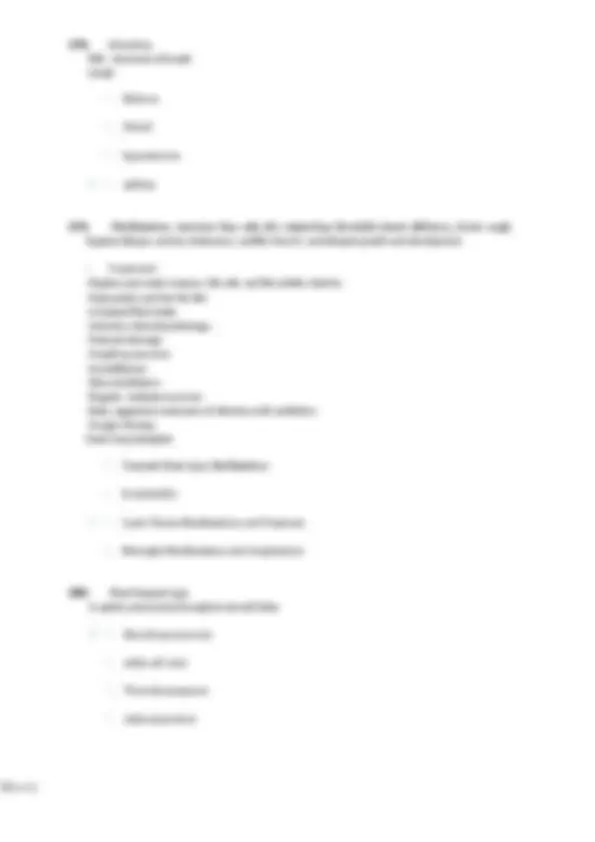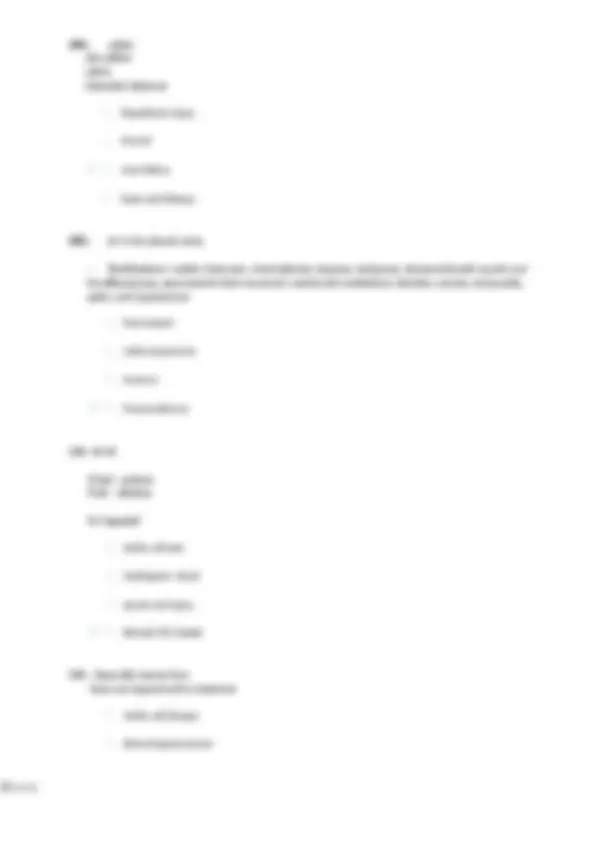Download Complications of Spinal Cord Injury and more Exams Pathophysiology in PDF only on Docsity!
NUR 2063 Essentials of Pathophysiology / NUR 2063
Pathophysiology Final Rasmussen University Winter
1) • Neither recessive nor dominant—co-dominant.
- Hemoglobin S causes erythrocytes to be abnormally shaped.
- Abnormal erythrocytes carry less oxygen and clog vessels, causing hypoxia and tissue ischemia. Exercise-induced asthma Chronic Bronchitis Sickle Cell Anemia Occupational asthma 2) blood flow reestablished to quickly Distributive shock Anaphylactic shock Reprofusion injury spinal cord injury 3) • Life-threatening complication of many conditions
- Results from an inappropriate immune response
- Widespread coagulation followed by massive bleeding because of the depletion of clotting factors
- Complications: shock and multisystem organ failure Disseminated intravascular coagulation - DIC Chronic Bronchitis Manifestations and Treatment Disseminated Intravascular Coagulation DIC Traumatic Brain Injury Complications 4) thyroid gland - T3, T4, calcitonin parathyroid gland - parathyroid hormone during acute respiratory failure
stress incontinence secondary brain injury Glands that regulate calcium 5) altered level of consciousness BP drops HR goes up hypotensive Glands that regulate calcium spinal cord injury shock sighs and symptoms Reprofusion injury 6) chest pain that occurs while a person is at rest and not exerting himself does not get better hemorrhagic stroke Bone electrolytes sickle cell crisis unstable angina 7) Abnormally low white blood cell count
- Normal range = 5,000 to 10,000 cells/mL3 blood beta cells Leukopenia Pneumonia CT scan 8) damage to the alveoli air can get in, but not out
Normal CO2 levels anemia symptoms Stabilize the patient 9) Manifestations
- May be vague and develop slowly, or may be sudden and severe.
- Symptoms may improve and then suddenly worsen.
- The outward appearance of the head is not an indication of the injury severity.
- Not being able to recall event details
- Indications of a concussion
- Changes in or unequal pupil size
- Seizures
- Asymmetrical facial features
- Fluid draining from the nose, mouth, or ears
- Fracture of skull or face
- Bruising of face
- Swelling at site of injury
- Scalp wound
- Impaired hearing, smell, taste, speech, or vision
- Inability to move one or more limbs
- Irritability (especially in children)
- Personality changes
- Unusual behavior
- Loss of consciousness
- Bradypnea
- Hypotension
- Restlessness
- Lack of coordination
- Lethargy
- Stiff neck
- Vomiting Acute Respiratory Distress Syndrome (ARDS) Manifestations and Treatment Acute Bronchitis Manifestations Tuberculosis Manifestations and Treatment Traumatic Brain Injury Manifestations
10) not enough ADH Alkalosis Stable Angina spinal cord injury diabetes insipidus 11) -Homozygous. -Most severe. -Almost all erythrocytes are sickled. Cushing's syndrome sickle cell crisis Sickle cell disease Normal CO2 levels 12) • Frequently caused by aspirin—prevents the conversion of prostaglandins, which stimulate leukotriene release, a powerful bronchoconstrictor.
- Can be fatal.
- Reactions can be delayed up to 12 hours after drug ingestion. Acute Bronchitis Drug-induced asthma stress incontinence Tuberculosis TB 13) pulmonary edema, wet coughing, shortness of breath, and dyspnea Acute lymphoblastic leukemia Left sided heart failure symptoms Right sided heart failure symptoms Cerebral Vascular Accident (CVA)
drugs stress incontinence Increased Intracranial Pressure Chronic Bronchitis Secondary hypertension 17) • Chronic inflammatory disease characterized by thickening and hardening of the arterial wall.
- Inflammatory process is triggered by a vessel wall injury.
- Lesions develop on the vessel wall and calcify over time.
- Leads to vessel obstruction, platelet aggregation, and vasoconstriction
- Complications: peripheral vascular disease, coronary artery disease, thrombi, hypertension, and stroke
- Manifestations: asymptomatic until complications develop
- Treatment: similar to dyslipidemia with the addition of angioplasty, bypass, laser procedures, and artherectomy Atherosclerosis Lobar pneumonia Tuberculosis TB Hypertension 18) kidney injury and prerenal injury can lead to hemostasis asthma bleeding seizure signs 19) • Second most common blood cancer
- Cancer of the leukocytes
- Leukemia cells abnormally proliferate, crowding normal blood cells Pneumonia Leukemia
Thalassemia hypoatremia 20) • Increased volume in the cranial cavity
- Causes: traumatic brain injury, tumor, hydrocephalus, cerebral edema, and hemorrhage coronary artery disease (CAD) Tuberculosis Secondary Infection Leukemia Manifestations and Treatment Increased Intracranial Pressure 21) Thalassemia major is the most severe form of beta thalassemia. It develops when beta globin genes are missing. The symptoms of thalassemia major generally appear before a child's second birthday. The severe anemia related to this condition can be life-threatening. Polycythemia Manifestations and Treatment Hemophilia A Thalassemia major Sickle Cell Anemia 22) Left ventricle cannot maintain adequate cardiac output. Cardiogenic shock Nosocomial pneumonia Anaphylactic shock esophageal varices 23) decreased blood volume alpha cells Encephilitis Hypovolemic shock Hypovolemia
found in one part of a tissue or an organ near these lymph node groups. Cells may also be found in the spleen. -Stage IV: Lymphoma cells are found in several parts of one or more organs or tissues, or the lymphoma cells are in an organ and in distant lymph nodes. -Recurrent: The disease returns after treatment. Coronary Artery Disease Hodgkin's Lymphoma Staging Pregnancy-induced hypertension Peripheral Vascular Disease 28) make glucagon - helps raise blood sugar levels alpha cells anemia symptoms hypoatremia appendicitis 29) has Reed-Sternberg cells tension pneumothorax Cushing's syndrome Normal HCO3 levels Hodgkin's lymphoma 30) • Manifestations: dyspnea, labored and shallow respirations, rales, productive cough with frothy sputum, hypoxia, cyanosis, fever, hypotension, tachycardia, restlessness, confusion, lethargy, and anxiety
- Treatment: endotracheal intubation with mechanical ventilator, oxygen therapy, corticosteroids, antibiotics (if bacterial infections are present), and emboli precautions Alzheimer's Disease Manifestations and Treatment Cystic Fibrosis Manifestations and Treatment Emphysema Manifestations and Treatment Acute Respiratory Distress Syndrome (ARDS) Manifestations and Treatment
31) inflammation of the meninges menigitis Balance pnemonia Alkalosis 32) damage to the brain caused by a different disorder injury responding to something else multiple sclerosis secondary brain injury Traumatic Brain Injury contact dermatitis 33) Another word for homeostasis Balance Stable Angina Encephilitis menigitis 34) No Reed-Sternberg cells Lobar pneumonia Non-Hodgkin's Lymphoma tension pneumothorax metastatic cancer 35) objective evidence of disease such as a fever sign Shock Ventilation
Emphysema Manifestations and Treatment
Chronic Bronchitis 39) shows brain's electrical activity by positioning electrodes over the scalp Thrombocytopenia Acute lymphoblastic leukemia Bone electrolytes EEG (electroencephalogram) 40) • Vary depending on the degree of damage and the specific nerves affected.
- Characterized by remissions and exacerbations.
- Exacerbations may last for days to months.
- Fever, hot baths, sun exposure, and stress can trigger or worsen these episodes. May progress without remissions.
- Fatigue
- Loss of balance
- Muscle spasms
- Paresthesia or abnormal sensation in any area
- Problems moving arms or legs
- Weakness in one or more arms or legs
- Unsteady gait
- Lack of coordination
- Tremor in one or more arms or legs
- Constipation and stool leakage
- Urinary frequency, urgency, hesitancy, or incontinence
- Vision issues (e.g., diplopia and vision loss)
- Decreased attention span, poor judgment, and memory loss
- Difficulty reasoning and solving problems
- Dizziness
- Hearing loss
- Sexual dysfunction
- Slurred speech Dysphagia Alzheimer's Disease Manifestations and Treatment Multiple Sclerosis Manifestations coronary artery disease (CAD) Cystic Fibrosis Manifestations and Treatment 41) -Heterozygous.
- Pain caused by tissue ischemia and necrosis
- Triggered by dehydration, stress, high altitudes, and fever
- Manifestations include abdominal pain, bone pain, dyspnea, delayed growth and development, fatigue, fever, jaundice, pallor, tachycardia, skin ulcers, angina, excessive thirst, frequent urination, priapism, and vision impairment
- Treatment -No cure, palliative -Stem cell research showing promise -Medications (e.g., Hydrea [hydroxyurea]) -Avoid sickling triggers -Other strategies: oxygen therapy, hydration, pain management, infection control, vaccinations, blood transfusions, bone marrow transplants, genetic counseling Acute Respiratory Distress Syndrome (ARDS) Manifestations and Treatment Acute Bronchitis Manifestations Alzheimer's Disease Manifestations and Treatment Sickle Cell Anemia Manifestations and Treatment 46) -Acquired outside the hospital or healthcare setting Stabilize the patient Community-acquired pneumonia Nosocomial pneumonia Potassium and Magnesium 47) -Most common form -Develops gradually over time Normal HCO3 levels Primary hypertension primary brain injury Stabilize the patient 48) • Decreased blood volume or circulatory stagnation resulting in inadequate tissue and organ perfusion Hypovolemia asthma
Extrinsic asthma Shock 49) Makes protein Acidosis hemostasis Ribosomes Alkalosis 50) • Rapidly developing respiratory failure
- Results from fluid accumulation in the alveoli due to a systemic or pulmonary event that is not cardiac in origin
- Causes: shock, burns, aspiration, and smoke inhalation acute hypoxemia
- Complications: respiratory and metabolic acidosis; pulmonary fibrosis; pneumothorax; bacterial infections; decreased lung function, muscle wasting; memory, cognitive, and emotional issues; and death Acute Bronchitis Emphysema Manifestations and Treatment Acute Respiratory Distress Syndrome (ARDS) Pregnancy-induced hypertension 51) acidosis alkalosis respiratory metabolic Stabilize the patient Arterial blood gas (ABG) Cerebral Vascular Accident (CVA) nonmodifiable risk factors 52) widespread simultaneous bleeding and clotting Disseminated intravascular coagulation DIC
Interstitial pneumonia or atypical Ventilation 53) • Result from meningeal irritation and neurologic damage.
- Similar to meningitis but with a more gradual onset.
- Most cases are mild and go undetected.
- Include: flulike symptoms, headache, neck rigidity, confusion, hallucinations, personality changes, diplopia, seizures, muscle weakness, paresthesia or paralysis, loss of consciousness, tremors, abnormal deep tendon reflexes, rash, and bulging fontanel. Treatment
- Usually self-limiting, requiring no treatment
- Rest
- Adequate nutrition, including plenty of liquids
- Respiratory support
- Reorientation and emotional support
- Analgesics and antipyretics to relieve headaches and fever
- Antiviral agents (if viral)
- Antibiotic therapy (if bacterial)
- Corticosteroids to reduce cerebral edema
- Antiseizure agents
- Sedatives to treat irritability and restlessness
- Physical, speech, and occupational therapy
- Prevention: vaccinations, wearing protective clothing, using mosquito repellant, and eliminating water sources Tuberculosis Secondary Infection Encephalitis Manifestations and Treatment Tuberculosis Primary Infection Alzheimer's Disease Manifestations and Treatment 54) level of consciousness Use Glasgow Coma Scale to measure Meningitis Manifestations and Complications A sensitive indicator of neurological change Cerebral Vascular Accident (CVA) EEG (electroencephalogram) 55) What to do if a suspected spinal cord injury
Stabilize the patient unstable angina Aspiration pneumonia Right sided heart failure symptoms 56) oxygen levels are down CO2 levels are up nonmodifiable risk factors coronary artery disease (CAD) Stabilize the patient during acute respiratory failure 57) • X-linked recessive bleeding disorder
- Deficiency or abnormality of clotting factor VIII
- Varies in severity
- Manifestations: bleeding or indications of bleeding (e.g., bruising, petechia, etc.)
- Treatment: clotting factor transfusions, recombinant clotting factors, desmopressin (DDAVP), and bleed precautions Extrinsic asthma Emphysema Thalassemia Hemophilia A 58) Venous return reduces because of external blood volume losses. appendicitis emphysema lecture Hypovolemic shock Nosocomial pneumonia


